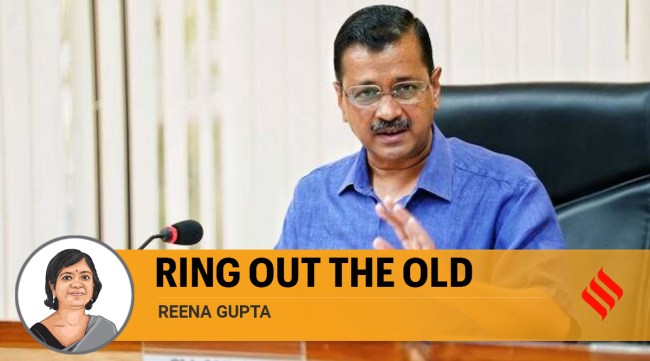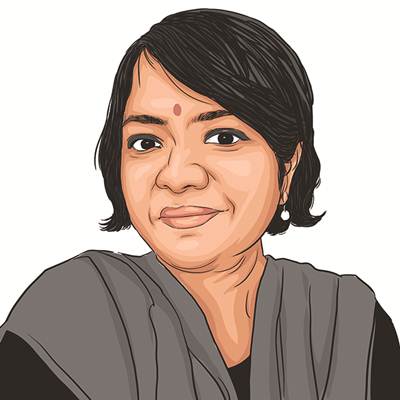Opinion AAP spokesperson Reena Gupta writes: To naysayers on Kejriwal government’s reforms, we can only say ‘tough luck’
Reena Gupta writes: Shailaja Chandra’s piece betrays the conventional mindset of the bureaucracy and the old guard
 Reena Gupta writes: Since 2014, the Arvind Kejriwal government has sought to infuse new energy into the dilapidated governance system, and if naysayers resist these changes, “tough luck” is all that we can say. (Twitter/@CMODelhi)
Reena Gupta writes: Since 2014, the Arvind Kejriwal government has sought to infuse new energy into the dilapidated governance system, and if naysayers resist these changes, “tough luck” is all that we can say. (Twitter/@CMODelhi) Sometimes, when power structures get too entrenched, every act of reforming them seems like defiance. And when an actor stepping in from the outside seeks to revitalise a broken system, their attempts are dubbed as chaos. Since 2014, the Arvind Kejriwal government has sought to infuse new energy into the dilapidated governance system, and if naysayers resist these changes, “tough luck” is all that we can say.
Shailaja Chandra’s article, ‘With great power, respect’ (IE, May 12) is a remnant of old attitudes. It betrays the conventional mindset of the bureaucracy and the old guard. What is most surprising is that despite having been a career civil servant, the writer has not mentioned civil services reform, and has squarely laid the blame on the Kejriwal government.
The need for civil services reform is evident from the meaning of the word “bureaucratic” used in common parlance. It means “connected with bureaucracy or bureaucrats and involving complicated official rules which may seem unnecessary”. Clearly, common people perceive bureaucracy more as a hindrance than a solution. Scholars of the Indian civil service system, like K P Krishnan and T V Somanathan, have noted that in respect of the neutral and fair implementation of the rule of law in dealing with individual citizens, the powerful and the influential have often received favourable treatment with the poor and the weak often treated shabbily.
Another malaise of the system is that promotions in the services are not linked to the outcomes that the civil servant has generated on the ground. Krishnan and Somanathan also point out that despite legal and constitutional protections, the service has not adequately resisted political interference, partly because of the incentive structure. They also observe that the civil service has not performed well when it comes to providing effective public services and promoting economic development. This is largely due to, among other things, inconsistent or arbitrary application of known policy, delays in decisions, “transaction costs” in money and time due to bribery, and lack of competence. It would be worthwhile to have these issues addressed, instead of using the old playbook of “just blame the politicians”.
Shailaja Chandra has rightly noticed that the bureaucracy in Delhi answers to multiple bosses. However, the areas in which these “bosses”, or to use a more suitable word “authorities”, exercise their powers have been very carefully delineated by the Constitution of India, laws passed by Parliament and the Delhi legislature. As such, it is not acceptable for any authority to decimate another.
The writer’s views also reflect the prevailing attitude that political tugs of war are meaningless. On the contrary, at a time when the Centre is increasingly damaging the federal structure, these supposed “tugs-of-war” are often a passionate struggle by the people to seek what is due to them: Enfranchisement, protection and welfare. The tussle in Delhi has been closely observed by the entire country, and the people have become alive to how the Centre has encroached on the powers of various states.
The administrative clashes until 2015 managed to stay away from the public eye because they were between competing ideas from the same outdated paradigm. But the Aam Aadmi Party came in with revolutionary ideas. At that time, the thought of high-quality education being provided in government schools was a dream so distant that no administrator even attempted it. And free health services were so unimaginable that most considered it a fool’s dream. Thus, AAP challenged the old ways of the administration, and many officers saw the scope to be more proactive and innovative. In these social times of media times, people find out about political events with the swipe of a finger. So, when administrative clashes do happen, they are bound to be noticed by the public.
What the writer has also got wrong is that Kejriwal did not come with a “long political and administrative acumen”. On the contrary, as a former civil servant, he had closely seen the rot in the system. He had first-hand experience of how corrupt politicians were often hand-in-glove with corrupt officials. Kejriwal understood the nuances of government procedure, but not with complacency — he argued for robustness in the system, and responsiveness from officials. Many civil servants also welcomed this. He and his ministers did see some officials as part of the problem but also acknowledged those who were honest, committed and efficient.
AAP and its leaders had the idealism of youth which many in the system found unpalatable. Kejriwal did not believe in power games and their diplomatic ways, because for him politics was a means for the welfare of the country, not an arena for massaging egos. In nine years of the AAP government, honest and efficient officers have continued to find their voice and implement ideas with robustness. The freedom, trust and respect that the writer has spoken of are already present in the Delhi government. The space for dissenting opinions and diverse perspectives is available — it is up to the personnel to use this space constructively, and not for doing the bidding of certain other “bosses” they serve.
The message is clear — the old guard is gone; the administration cannot be located in tall ivory towers anymore. Today, administrators are not mere paper pushers. They are responsive and innovative. And when mindless rules impede their functioning at the cost of public welfare, those rules need to be reconsidered and reformed. It is not just elections that make it a people’s government — it also requires a robust, responsive and compassionate bureaucracy.
The writer is national spokesperson of AAP






